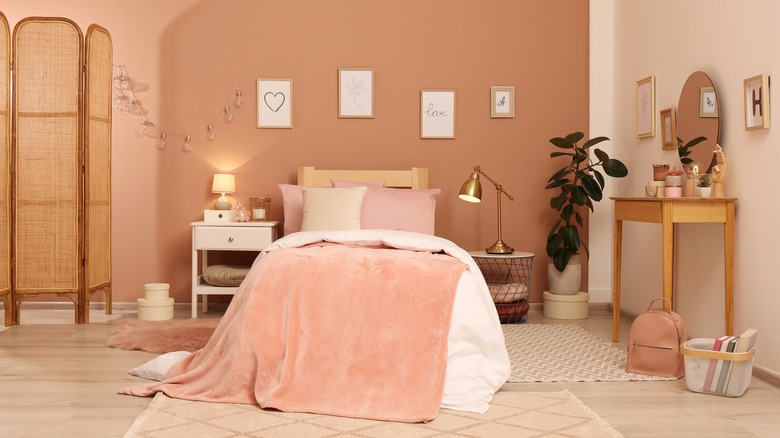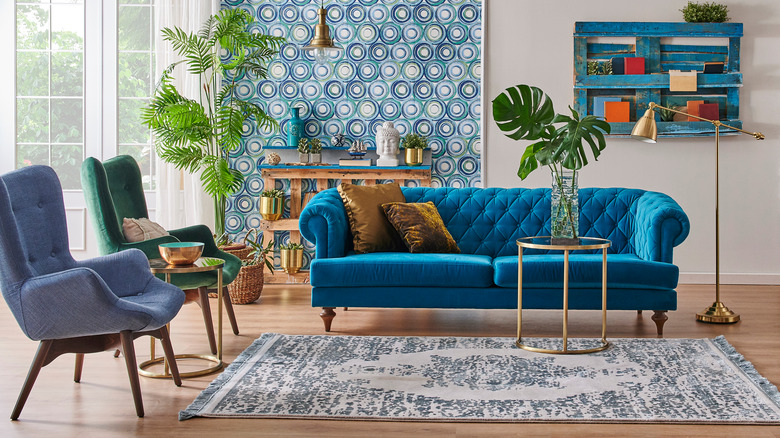4 Ways To Style A Rug In Your Dorm Room
Dorm rooms have developed a bit of a reputation over the years, and it's no surprise why. According to The Beck Group, stark walls, stiff mattresses, and decades-old furniture can damper your college years. With many universities requiring freshmen to stay on campus, it's an unavoidable part of the experience. Making a dorm room feel like your own presents a unique set of challenges, but anything is possible with clever styling, simple fixes, and stylish décor.
Rugs are one of the easiest ways to revamp a room, especially if you're working with the bland linoleum that's so common in residence halls across the country. Rules are typically pretty strict regarding DIY upgrades and decorations so rooms can be reassigned quickly at the end of the school year, but simply laying down a rug can do wonders for your space — without causing any damage. Continue reading to learn our top tips for incorporating rugs into your dorm room.
1. Add a pop of color
When styling such a small space, it's easy to get overwhelmed with options. Instead of picking up everything that catches your eye, stick to a color scheme. While you most likely won't be able to paint the walls, a rug is an easy way to bring a healthy dose of color into a space and cover up dull floors. Select a rug you love and build a palette around it — soon enough, you'll have a cohesive-looking dorm room.
For bonus points, coordinate with your roommate ahead of time. When living in such proximity to another person, it's easy to clash styles. To avoid that, chip in on a large rug that fills the room with color and matches both of your aesthetics. According to Verywell Mind, specific colors can influence emotions and productivity. If you want to create a relaxing haven, opt for subtle greens and blues. To increase energy and productivity, warm colors like yellow and orange may do the trick, via Digital Synopsis.
2. Insulate your space
Living in a building with dozens or even hundreds of other college students will be noisy. People are constantly coming and going, walls are thin, and residents are packed in like sardines. Surprisingly, rugs can help. According to Soundproof Central, they can help absorb vibrations and dampen noise, allowing you to study in peace and avoid noise complaints from your downstairs neighbors.
If you live in a cooler climate, rugs can also serve the additional purpose of insulating and trapping heat in a room, per The Carpet Institute of Australia. While they won't replace your space heater, they can help prevent heat loss and protect your feet from ice-cold flooring. For the biggest benefits, opt for a thick wool material, or layer a pad underneath your current rug. Size also matters; choose a bigger rug that covers a large percentage of your floor space, or place multiple smaller rugs throughout the room. Your feet will thank you.
3. Introduce patterns and texture
Student housing is usually built for convenience, not style, so it can lean pretty bland. A rug can be a focal point in the room and allow you to incorporate interesting textures, patterns, and shapes without causing damage. Per Britannica, texture is an essential element of interior design, and a residence hall's standard furniture and white walls don't bring much to the table. Incorporating floor coverings is one of the easiest ways to keep your room from looking flat or dull.
If you have a roommate, this is another chance to collaborate on the shared aesthetic of your room. Go for a Persian rug to add an old-world depth, keep it simple and soft with something shaggy or faux fur or opt for an attractive shape like a round rug to add some soft lines and quirkiness. Popular prints include geometric designs, animal prints, and neutral tones.
4. Layer it up
Layering rugs have become a major trend recently, and it's no surprise why. This bohemian look allows for more freedom, more creativity, and all the same benefits. Layering makes it easier to incorporate multiple colors, adds texture, and insulates better than just one rug. It can also help cover a large or awkward floor space, reducing the stress of finding the perfect rug size for your dorm room. To successfully layer without looking too busy, try to keep your rugs in the same color family, combine patterns with common elements, and play with different textures, per Chloe Dominik.
Moving into a dorm can be a nerve-wracking experience, but décor can help your room feel less clinical and more like home — even if you'll only be there for a few months. Incorporating a rug (or two or three) is a low-effort way to bring in many benefits and personalize your space without damaging the room.




